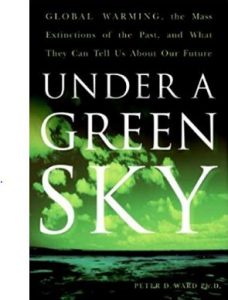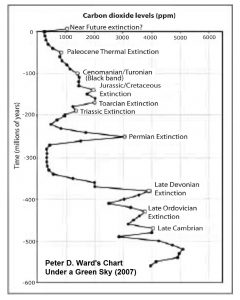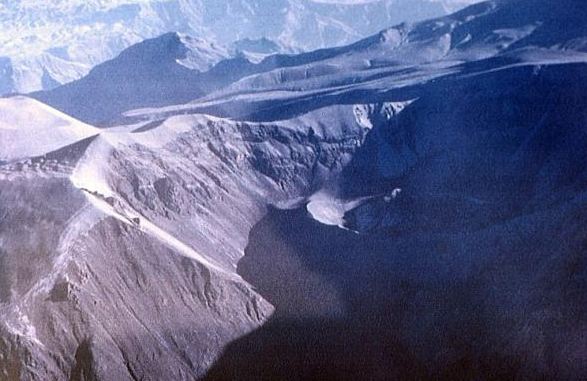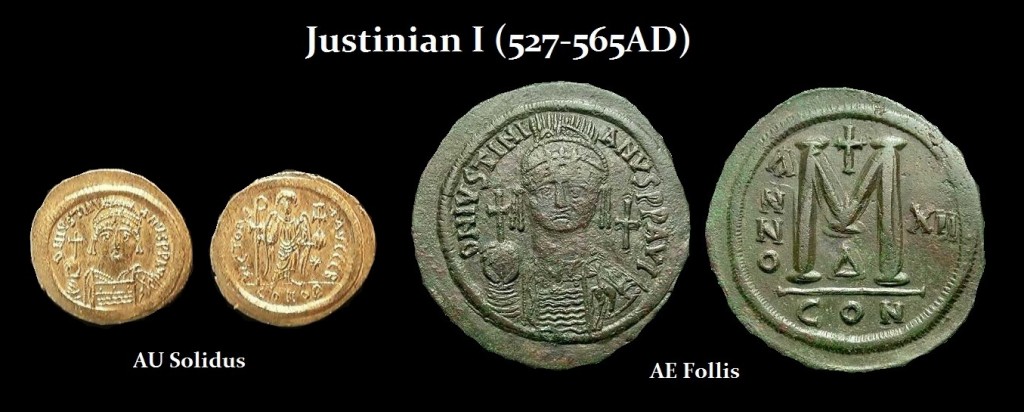The Extinction Rebellion Propaganda Exposed
 There has been a rise in Europe of what is called the Extinction Rebellion, which boasts: “We are in the midst of a mass extinction of our own making.” This has been based upon a book that has put forth a theory that one of the five mass extinctions in history was caused by CO2 levels. The data has often been presented in charts that have been completely distorted to get the youth to assemble in destructive protests. Here is a chart easily found by just searching the internet. Note its time frame extends back to only 800,000 years. This is how they create fake charts to support a predetermined conclusion. They base their conclusion on the book that states one of the big five extinctions was due to CO2. The event that the book is discussing was the Permian Extinction which was 251 million years ago with the claim that the C02 level was 3,000 ppm compared to a global average atmospheric carbon dioxide in 2018 of 407.4 parts per million.
There has been a rise in Europe of what is called the Extinction Rebellion, which boasts: “We are in the midst of a mass extinction of our own making.” This has been based upon a book that has put forth a theory that one of the five mass extinctions in history was caused by CO2 levels. The data has often been presented in charts that have been completely distorted to get the youth to assemble in destructive protests. Here is a chart easily found by just searching the internet. Note its time frame extends back to only 800,000 years. This is how they create fake charts to support a predetermined conclusion. They base their conclusion on the book that states one of the big five extinctions was due to CO2. The event that the book is discussing was the Permian Extinction which was 251 million years ago with the claim that the C02 level was 3,000 ppm compared to a global average atmospheric carbon dioxide in 2018 of 407.4 parts per million.
There are what people call the big five mass extinctions known as the Ordovician, Devonian, Permian, Triassic, and Cretaceous. The Ordovician–Silurian extinction was a global extinction event that occurred during the Hirnantian Age (445.2 million to 443.8 million years ago) of the Ordovician Period and the subsequent Rhuddanian Age (443.8 million to 440.8 million years ago) of the Silurian Period. This extinction was caused by the ice age resulting in eliminating about 85% of all Ordovician.
The Devonian Extinction took place 375 million years ago — 360 million years ago and resulted in the death of 70% to 80% of most life on the planet. The Permian Extinction took place about 251 million years ago and terminated 90% to 97% of all life. The generally accepted cause was either an asteroid impact or volcanic activity.
The Triassic Extinction took place about 201 million years ago and is one of the major extinction events affecting life on land and in the oceans. In the oceans, a whole class and 23–34% of marine life disappeared. One theory points to massive lava eruptions during the breakup of the super-continent Pangea, which might have released vast amounts of carbon dioxide, causing runaway global warming. Yet still, other scientists suspect asteroid strikes are to blame, but there have been no craters discovered as of yet unless they are under the ocean.
It was this Cretaceous–Paleogene Extinction event, that was a sudden mass extinction of some 75% of the plant and animal species on Earth approximately 66 million years ago. An asteroid impact is believed to have been the cause for the extinction event that wiped out the world’s non-avian dinosaurs, from T-Rex to the three-horned Triceratops. Indeed, a huge crater off Mexico’s Yucatan Peninsula supports the asteroid hypothesis. Most mammals, turtles, crocodiles, and frogs survived, along with birds as well as most sea life, including sharks, starfish, and sea urchins.
 If we take the graph from the paleontologist Peter D. Ward’s book, “Under a Green Sky” published in 2007, the proposition of simply measuring the average CO2 concentration and concluding that CO2 is the reason for mass extinctions is a really questionable analysis. That is like claiming that carrots are deadly because it is a fact that everyone who has ever eaten a carrot has eventually died. It is true that CO2 levels have been massively higher than they are today. Looking at his chart, we are at a historic low similar to the 5,000-year low in interest rates. Any uptick is by no means cause for the assumption that will become extinct in 12 years.
If we take the graph from the paleontologist Peter D. Ward’s book, “Under a Green Sky” published in 2007, the proposition of simply measuring the average CO2 concentration and concluding that CO2 is the reason for mass extinctions is a really questionable analysis. That is like claiming that carrots are deadly because it is a fact that everyone who has ever eaten a carrot has eventually died. It is true that CO2 levels have been massively higher than they are today. Looking at his chart, we are at a historic low similar to the 5,000-year low in interest rates. Any uptick is by no means cause for the assumption that will become extinct in 12 years.
The Permian Extinction was marked by a major volcanic event which may have also involved an asteroid hit, which coincided with high atmospheric CO2. As stated above, the C02 level according to Ward was 3,000 ppm compared to a global average atmospheric carbon dioxide in 2018 of 407.4 parts per million. The Permian Extinction destroyed more than 90% of all species and nearly 97% of all living things. While its origins have long been a puzzle for paleontologists with some arguing it was caused by the impact of an asteroid and those who thought something more complicated was at work.
 It was Ward who agreed that it was an asteroid that struck in Mexico which had killed the dinosaurs. However, he has asserted that his investigation into the Permian Extinction implied he attributed to CO2 lacking evidence of a crater. In his investigations of the fates of several groups of mollusks during those extinctions and others, he concluded that the near-total devastation at the end of the Permian Extinction was caused by rising levels of carbon dioxide leading to climate change.
It was Ward who agreed that it was an asteroid that struck in Mexico which had killed the dinosaurs. However, he has asserted that his investigation into the Permian Extinction implied he attributed to CO2 lacking evidence of a crater. In his investigations of the fates of several groups of mollusks during those extinctions and others, he concluded that the near-total devastation at the end of the Permian Extinction was caused by rising levels of carbon dioxide leading to climate change.
Ward argued that the Permian Extinction event was distinguished with very high atmospheric CO2 (3,000 ppm) levels which created a runaway Greenhouse Effect. He argued that this would have heated the Earth’s oceans to the point where they could no longer contain dissolved oxygen. Warm water, he argued, holds less dissolved gas than cold water. Therefore, he assumed that the Permian oceans became extremely warmed and devoid of oxygen. He then theorized that this type of environment would result in sulphur creating anaerobic bacteria. Sulphur could combine with hydrogen creating hydrogen sulphide which would lead to mass extinction because high levels of bacteria creating hydrogen sulphide would kill most of its inhabitants. However, Ward’s proposition remains only a theory. There is not enough data to confirm his theory is correct.
The Extinction marking the end of the Cretaceous period 65 Million years ago, where Iridium is found worldwide, provided conclusive evidence for a meteorite impact as the cause. The debate over the cause of the Largest Extinction in Earth History, Permian Extinction, will continue until more conclusive worldwide evidence is found.
Nevertheless, it has been Ward’s opinion that has given justification to this CO2 climate change hysteria. Part of the problem in confirming an asteroid impact that was the case is the fact that the Earth’s crust is convected down into the mantle every 200 Million years like a conveyor belt. Since the Permian Extinction occurred about 250 million years ago, most of the rocks would have reprocessed into the Mantle by now leaving no evidence of a crater. Yes, New York City will be consumed under the mantle within 200 million years! Does that mean we should move to the center of the ocean and claim land beneath the sea and wait for that to become beachfront?
When we simply run all of this through our correlation models, low and behold, a very obvious fact emerges. What we can ascertain from correlation models that will determine the cycles from all events is that there were major periods of volcanic eruptions which correspond to the Permian Extinction, Triassic Extinction, Jurassic Cretaceous Extinction, and the Cretaceous–Paleogene Extinction. This much we know does increase CO2, but it also throws ash into the atmosphere which reduces sunlight and creates a volcanic winter.
In the upland region of Southern Peru, there is a volcano by the name of Huaynaputina. It exploded on February 19th, 1600, and is recorded as the largest volcanic explosion ever in South America. However, studies have shown around the world that this volcano indeed altered the climate and took place during a solar minimum. Scientists now believe that its eruption had a devastating effect around the world both in Europe as well as in China and Korea. This impacted agriculture and furthered the contagion cycles from disease. In fact, the Great Famine in Russia was caused by this eruption. The Russian famine of 1601–1603 was Russia’s worst famine in terms of a proportional effect on the population. More than two million people starved to death which was one-third of the Russian people. The famine compounded the Time of Troubles and weakened Russia allowing it to be invaded by the Polish-Lithuanian Commonwealth. This famine was part of worldwide record cold winters and crop disruption, which geologists in 2008 linked to the 1600 volcanic eruption of Huaynaputina in Peru that has been classified as a VEI6 putting some 30 cubic kilometers of earth into the sky more than 8 miles high. Contemporary accounts state that some regions did not see the sun for two months. Without the sun, crops fail.
I have even shown by correlating weather and volcanoes that Napoleon was defeated by the Mini Ice Age. There was a major volcanic eruption in the West Indies in 1812, which has been called the 1808/1809 Mystery Volcanic Eruption which seems to have set in motion a Mini Ice Age during the early 1800s. This event preceded the 1815 eruption of Mount Tambora (VEI 7) which produced the Year Without a Summer in 1816. Napoleon was defeated really by Volcanoes.
If we look back in time through the historical record, we discover another period where there appears to be a major convergence of volcanic activity which creates Global Cooling and the subsequent famine. There were the great volcanic eruptions that created the extreme weather events of 535–536 AD during the reign of the Byzantine Emperor Justinian I (527-565 AD). A mysterious cloud appeared over the Mediterranean basin according to the historian Procopius of Caesarea (Procopius Caesarensis; c. 500-560 AD) who wrote: “The sun gave forth its light without brightness, and it seemed exceedingly like the sun in eclipse, for the beams it shed were not clear.” This was a volcanic cloud that blocked the sun. But it was not a volcano in that region. The cloud’s appearance created a climate cooling for more than a decade. Crops failed, and there was widespread famine. This also sets in motion a pandemic known as the Plague of Justinian (541-542), which swept through the Eastern Roman Empire killing 5,000 people per day in Constantinople. The dating of this is extremely close to the famous civil unrest known as the Nika Revolt of 532 AD, which preceded the cloud account of Procopius and the plague.
Scientists had postulated that the Global Cooling set in motion by a giant volcanic winter 535-536 AD may have been the result of the eruption of Ilopango in El Salvador, which filled Earth’s atmosphere with ash as did Mount Tambora in 1815. However, as the SMITHSONIAN reported back in 2010, “researchers say there were two eruptions—one in 535 or 536 in the northern hemisphere and another in 539 or 540 in the tropics—that kept temperatures in the north cool until 550.” This has emerged from studying the ice core samples collected in Antarctica and Greenland with data from tree rings. According to the correlation of this data, “nearly all extreme summer cooling events in the northern hemisphere in the past 2,500 years can be traced to volcanoes,” reported the Smithsonian.
Ward’s chart which has caused all the ruckus is based upon a questionable model, to begin with. The GEOCARB model is supposed to estimate major trends in carbon dioxide throughout time. However, this model works with some assumptions. CO2 is naturally released into the atmosphere as volcanic degassing and consumed by chemical weathering of rocks on land both of which have nothing to do with human activity. You can change model parameters of the CO2 degassing rate (the flux of CO2 from the solid Earth to the atmosphere), the existence of land plants, and the relative land areas and completely alter the forecast. A second model known as GEOCARBSULF allows estimates of ancient oxygen levels throughout time. Therefore, they combine these two models to provide a presumption of how much these two gases have varied throughout time. Obviously, the atmospheric levels of carbon dioxide have moved through cyclical patterns throughout the history of the earth. Indeed, the earth has moved through periods of predominant tropical weather systems on one extreme to ice ages on the other extreme of the cycle.
Although none of the various models attempting to calculate carbon dioxide and oxygen levels over the last 500 million years has any valid precision, they have been used to discern longer-term trends that are greater than 1 million years in length. Nevertheless, they are based on presumptions and are attempting to forecast the past with very little hard data upon which to base the forecast. This is like watching a week’s worth of trading in the Dow and then used those 5 days to try to project what the Dow would have done over the past 100 years. Obviously, this methodology is highly questionable. We would need a data set with hard confirmed interactions from which we could ever hope to extrapolate past history.
Those who have argued that CO2 is the exclusive reason for climate change have disregarded other possible causes and factors, such as the variation in solar cycle heating over time which operates in a 300-year cycle or changes in heating from the interior of the earth which have included volcanic eruptions. Correlations clearly show that during periods of Solar Minimum, this is when we see the greatest number of volcanic eruptions. Solar Minimum is also simultaneously the maximum output of Gamma Rays which are the most energetic form of light and are produced by the hottest regions of the universe. They are also produced by such violent events as supernova explosions or the destruction of atoms, and by less dramatic events, such as the decay of radioactive material in space.
To simply disregard all other factors for CO2 as irrelevant is irresponsible. Instead, this CO2 group has preferred to attribute all climate changes to greenhouse gases with only theory. The study of ice core samples from glaciers formed in the Pleistocene epoch glacial event has shown that there was an increase in carbon dioxide values, but again they varied greatly. There were clearly short-term periods of sharp rises in CO2 which are most likely attributed to volcanic eruptions. What they are doing is simply looking at what may be the result rather than the cause. This is a dangerous assumption to make for it precludes investigation of other factors or the more likely source is a combination of events that produce a rogue wave of energy and events.
Therefore, the average extinction cycle would be about 75.6 million years. That would not imply we have any serious risk of such an event. All the arguments claiming carbon dioxide must be curbed are strikingly absent of definitive proof that such extinctions are exclusively caused by CO2 levels rising. Oxygen began to climb some 375 billion years ago and the levels of carbon dioxide plummeted and only rose again sometime in the Mesozoic era. Carbon Dioxide was plentiful through much of that error culminating at a maximum level during the Late Jurassic period. About 150 million years ago, the carbon dioxide level begins to crash coming to a minimum level today.
From a pure cyclical perspective, during the last 200 years, carbon dioxide has been rising once again since the last mini Ice Age. We are far from the historic levels of the past, but are they rising coinciding with the more rapid movement of the polls and the crash in the solar activity of the sun? It may be that we are about to see dramatically colder winters, not because of CO2, but for a combination of factors, nobody seems to be investigating because all the grant money is being sucked up by the CO2 crowd desperate to support their theories in fear of their funding coming to an end.




